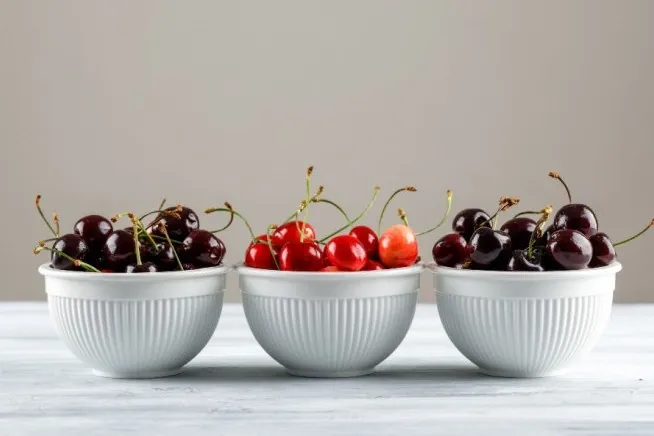Introduction
The production of sweet cherries represents a highly competitive agricultural sector with significant economic prospects, particularly in Italy, one of the leading European producers. Despite the successes achieved in the sector, cherry cultivation faces numerous challenges, including physiological disorders and biotic and abiotic stress.
Among these, cracking is of particular concern as it can lead to yield losses of up to 90%. Although breeding programs have developed new varieties that are more resistant to cracking, the effects of climate change, characterized by alternating droughts and intense rainfall, continue to cause losses even in the new varieties.
Additionally, the use of rain covers in orchards, while reducing mechanical splitting caused by rain, is not always effective in preventing hygroscopic splitting due to the fruit's surface moisture.
During the 2023 season, a trial was conducted to apply calcium and potassium salts foliar.
The experiment was carried out in a commercial sweet cherry orchard cv. 'Regina' in Lagnasco, Piedmont, grafted onto 'Gisela 5' and covered with rain and hail nets. Foliar applications were performed on 15 trees with the following 3 commercial products: Stimulante Plus® (12% w/w calcium oxide), Set® (12% w/w calcium oxide + 1% w/w boron), and Abundantia® (16% w/w potassium oxide + 4% w/w nitrogen).
The application was conducted in 4 applications from the bud break stage to fruit set (Table 1). The effectiveness of the treatment was tested by comparing the 15 treated plants (SPRAY) with 15 untreated plants (CTRL) by analyzing plant biometric data and post-harvest fruit quality.
| Table 1: Treatment Schedule |
|---|
| Phenology | Bud Break | Flower Buds | Petal Fall | Fruit Set |
| Date | Mar. 23 | Mar. 31 | Apr. 09 | Apr. 16 |
| Commercial Product | Stimulante Plus® (1 L/ha) + Set® (3 L/ha) | Stimulante Plus® (1 L/ha) + Set® (3 L/ha) | Stimulante Plus® (1 L/ha) + Set® (3 L/ha) | Stimulante Plus® (1 L/ha) + Abundantia® (7 L/ha) |
Obtained Results
Shoot Growth and Chlorophyll Concentrations:
Foliar treatments had a significant impact on shoot growth (Table 2) and chlorophyll concentrations (Table 3) in the leaves (SPAD index); however, the average yield per plant did not show differences between treatments.
The SPRAY treatment showed greater shoot growth compared to the control (CTRL) in all measurements, with the highest values recorded on June 1, 8, and 16. Regarding chlorophyll, the SPRAY treatment showed the highest concentrations during June.
| Table 2: Weekly Shoot Elongation |
|---|
| Day | Treatment | Shoot Elongation (cm) |
| May 26 | CTRL
SPRAY | 19.1 b
21.8 ab |
| Jun 01 | CTRL
SPRAY | 22.2 ab
27.3 a |
| Jun 08 | CTRL
SPRAY | 23.2 ab
27.0 a |
| Jun 16 | CTRL
SPRAY | 23.9 ab
28.4 a |
| LSD (p-value ≥ 0.05) |
| Table 3: Monthly SPAD Index |
|---|
| Month | Sample | SPAD Index |
| Apr | CTRL
SPRAY | 37.4 bc
35.8 c |
| May | CTRL
SPRAY | 36.3 c
39.8 ab |
| Jun | CTRL
SPRAY | 35.9 c
41.6 a |
| LSD (p-value ≥ 0.05) |
Mechanical and Biochemical Characteristics of the Fruits:
The foliar treatments significantly affected the characteristics of the fruits. The SPRAY treatment reduced the firmness, chroma, and hue angle of the fruits compared to the CTRL group. This indicates a softening and darker saturation in the epidermis of the treated fruits, with a less intense red hue compared to the controls.
The reduction in texture and saturation was accompanied by an increase in total soluble sugars, which suggests an acceleration in the maturation of fruits subjected to foliar treatment. However, the treatments did not affect the acidity of the fruits, which in cherries typically tends to increase during ripening.
| Table 4: Production and Quality Characteristics |
|---|
Treatment
| Production
(kg/plant) | Acidity
(meg/L) | Sugars
(°Brix) | Firmness
(Shore) | Color |
L* (C) | C* (C) | h° |
| SPRAY | 6.36 | 96.6 | 14.5a | 55.4a | 40.8 | 18.8a | 21.1a |
| CTRL | 6.06 | 99.4 | 13.9b | 52.0b | 40.4 | 11.86b | 16.7b |
| LSD (p-value ≥ 0.05) | ns | ns | *** | *** | ns | *** | *** |
Bioactive Compounds and Cracking Incidence:
Treatments with Ca and K salts have improved the nutraceutical properties of the fruits. The total anthocyanin content (TAC) and antioxidant activity (AA) were significantly higher in the treated group compared to the control. However, the total polyphenol content (TPC) did not show significant differences between treatments.
The cracking incidence rate was significantly reduced in the SPRAY group compared to the control. This effect is attributed to calcium's ability to promote the formation of bonds between cell components, making the skin and pulp more rigid, and to the reduction of water absorption due to the more negative osmotic potential on the fruit surface.
The Cracking Index (CI) was assessed by quantifying the susceptibility of cherries to cracking based on their ability to absorb water. This method effectively reproduces the incidence of cracking induced by high levels of environmental humidity, a common issue in modern orchards protected by rain shelters, including the one used for this study.
| Table 5: Qualitative and Nutraceutical Characteristics |
|---|
| Treatment | TPC
mg(GAE)/100g fp) | TAC
mg(CYAN)/100g fp | AA
mmolfe3+/100g fb | CI
% |
| SPRAY | 96.7 | 47.55a | 36.04a | 2.53b |
| CTRL | 90.2 | 30.49b | 25.20b | 5.73a |
LSD (p-value ≥ 0.05)
| ns | ** | ** | ** |
Source: Varaldo, A., Alchera, F., Brigante, L., and Giacalone, G. (2023) 'Foliar applications of calcium and potassium increase cracking resistance and enhance fruit quality in sweet cherries', Italus Hortus, 30(3), pp. 25-36. doi:10.26353/j.itahort/2023.3.2536.
Image: SL Fruit Service
Alice Varaldo and Giovanna Giacalone
University of Turin – DISAFA
Cherry Times - All rights reserved












